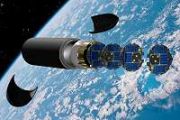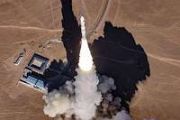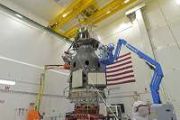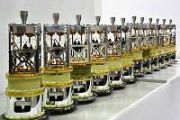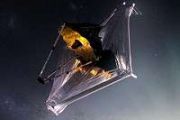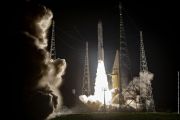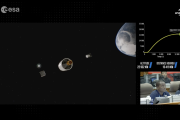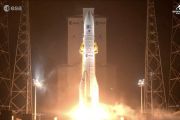
Copernical Team
Bennu samples contain water, carbon and organic 'building blocks of life'
 NASA said Wednesday that Bennu asteroid samples collected by the OSIRIS-Rex mission contain water, carbon and organic molecules - the building blocks of life.
NASA Administrator Bill Nelson said it's an exciting discovery, with the initial analysis of the material showing abundant carbon.
"At nearly 5% carbon by weight, carbon being the central element of life, far exceeding our
NASA said Wednesday that Bennu asteroid samples collected by the OSIRIS-Rex mission contain water, carbon and organic molecules - the building blocks of life.
NASA Administrator Bill Nelson said it's an exciting discovery, with the initial analysis of the material showing abundant carbon.
"At nearly 5% carbon by weight, carbon being the central element of life, far exceeding our Keysight to Provide Payload Testing Solution for First SWISSto12 HummingSat Mission
 Keysight Technologies, Inc. (NYSE: KEYS) announces that SWISSto12, one of Europe's fastest growing satellite and radio frequency (RF) payload manufacturers, has selected the Keysight Payload Test System (PTS) to validate the RF payloads of its first HummingSat geostationary satellite, Intelsat 45. The HummingSat is a small, innovative telecommunications satellite developed in collaboration with
Keysight Technologies, Inc. (NYSE: KEYS) announces that SWISSto12, one of Europe's fastest growing satellite and radio frequency (RF) payload manufacturers, has selected the Keysight Payload Test System (PTS) to validate the RF payloads of its first HummingSat geostationary satellite, Intelsat 45. The HummingSat is a small, innovative telecommunications satellite developed in collaboration with Five Things to Know about NASA's Deep Space Optical Communications
 NASA's pioneering Deep Space Optical Communications (DSOC) experiment will be the first demonstration of laser, or optical, communications from as far away as Mars. Launching with NASA's Psyche mission to a metal-rich asteroid of the same name on Thursday, Oct. 12, DSOC will test key technologies designed to enable future missions to transmit denser science data and even stream video from the Re
NASA's pioneering Deep Space Optical Communications (DSOC) experiment will be the first demonstration of laser, or optical, communications from as far away as Mars. Launching with NASA's Psyche mission to a metal-rich asteroid of the same name on Thursday, Oct. 12, DSOC will test key technologies designed to enable future missions to transmit denser science data and even stream video from the Re Relativity Space and Intelsat sign multi-launch agreement for Terran R
 Relativity Space has signed a multi-year, multi-launch Launch Services Agreement (LSA) with Intelsat, operator of the largest integrated space and terrestrial network in the world. Under the agreement, Relativity will launch Intelsat satellites on Terran R as early as 2026.
As a medium-to-heavy-lift, reusable launch vehicle made for growing satellite launch demand and eventually multiplane
Relativity Space has signed a multi-year, multi-launch Launch Services Agreement (LSA) with Intelsat, operator of the largest integrated space and terrestrial network in the world. Under the agreement, Relativity will launch Intelsat satellites on Terran R as early as 2026.
As a medium-to-heavy-lift, reusable launch vehicle made for growing satellite launch demand and eventually multiplane DICT transforms Northern Luzon with 438 satellite broadband sites
 The Department of Information and Communications Technology (DICT) in the Philippines has successfully collaborated with internet service provider Stellarsat Solutions Inc. and its partner Kacific Broadband Satellites to achieve a key milestone in its effort to provide equitable broadband connectivity across the country, under a National Broadband Plan.
This transformative project, integra
The Department of Information and Communications Technology (DICT) in the Philippines has successfully collaborated with internet service provider Stellarsat Solutions Inc. and its partner Kacific Broadband Satellites to achieve a key milestone in its effort to provide equitable broadband connectivity across the country, under a National Broadband Plan.
This transformative project, integra A new way to erase quantum computer errors
 Quantum computers of the future hold promise in solving all sorts of problems. For example, they could lead to more sustainable materials, new medicines, and even crack the hardest problems in fundamental physics. But compared to classical computers in use today, rudimentary quantum computers are more prone to errors. Wouldn't it be nice if researchers could just take out a special quantum erase
Quantum computers of the future hold promise in solving all sorts of problems. For example, they could lead to more sustainable materials, new medicines, and even crack the hardest problems in fundamental physics. But compared to classical computers in use today, rudimentary quantum computers are more prone to errors. Wouldn't it be nice if researchers could just take out a special quantum erase Fly across Mars's 'labyrinth of night' with Mars Express
 Nestled between the colossal martian 'Grand Canyon' (Valles Marineris) and the tallest volcanoes in the Solar System (the Tharsis region) lies Noctis Labyrinthus - a vast system of deep and steep valleys that stretches out for around 1190 km (roughly the length of Italy here on Earth).
This video visualises a flight over the eastern part of Noctis Labyrinthus as seen by Mars Express's High
Nestled between the colossal martian 'Grand Canyon' (Valles Marineris) and the tallest volcanoes in the Solar System (the Tharsis region) lies Noctis Labyrinthus - a vast system of deep and steep valleys that stretches out for around 1190 km (roughly the length of Italy here on Earth).
This video visualises a flight over the eastern part of Noctis Labyrinthus as seen by Mars Express's High Removal of magnetic spacecraft contamination within extraterrestrial samples easily carried out
 For decades, scientists have pondered the mystery of the moon's ancient magnetism. Based on analyses of lunar samples, its now-deceased magnetic field may have been active for more than 1.5 billion years - give or take a billion years. Scientists believe it was generated like the Earth's via a dynamo process, whereby the spinning and churning of conductive liquid metal within a rocky planet's co
For decades, scientists have pondered the mystery of the moon's ancient magnetism. Based on analyses of lunar samples, its now-deceased magnetic field may have been active for more than 1.5 billion years - give or take a billion years. Scientists believe it was generated like the Earth's via a dynamo process, whereby the spinning and churning of conductive liquid metal within a rocky planet's co China announces plan to build world's largest deep-sea neutrino telescope
 China has announced plans to build the world's largest deep-sea neutrino telescope in the western Pacific Ocean.
The project, called "Trident", is expected to be completed in 2030 and will be used to study the universe's most extreme phenomena, such as supernova explosions and black hole eruptions.
Neutrinos are tiny particles that have no electrical charge and very little mass. They
China has announced plans to build the world's largest deep-sea neutrino telescope in the western Pacific Ocean.
The project, called "Trident", is expected to be completed in 2030 and will be used to study the universe's most extreme phenomena, such as supernova explosions and black hole eruptions.
Neutrinos are tiny particles that have no electrical charge and very little mass. They "Starquakes" could explain mystery signals
 Fast radio bursts, or FRBs, are an astronomical mystery, with their exact cause and origins still unconfirmed. These intense bursts of radio energy are invisible to the human eye, but show up brightly on radio telescopes. Previous studies have noted broad similarities between the energy distribution of repeat FRBs, and that of earthquakes and solar flares.
However, new research at the Univ
Fast radio bursts, or FRBs, are an astronomical mystery, with their exact cause and origins still unconfirmed. These intense bursts of radio energy are invisible to the human eye, but show up brightly on radio telescopes. Previous studies have noted broad similarities between the energy distribution of repeat FRBs, and that of earthquakes and solar flares.
However, new research at the Univ 

